CCNA – Operations 1
Here you will find answers to Operations Questions (Part 1)
Question 1:
What are two reasons that a network administrator would use access lists? (Choose two.)
A. to control vty access into a router
B. to control broadcast traffic through a router
C. to filter traffic as it passes through a router
D. to filter traffic that originates from the router
E. to replace passwords as a line of defense against security incursions
Answers: A C
Question 2:
A single 802.11g access point has been configured and installed in the center of a square office. A few wireless users are experiencing slow performance and drops while most users are operating at peak efficiency. What are three likely causes of this problem? (Choose three.)
A. mismatched TKIP encryption
B. null SSID
C. cordless phones
D. mismatched SSID
E. metal file cabinets
F. antenna type or direction
Answers: C E F
Question 3:
Refer to the exhibit. How many broadcast domains exist in the exhibited topology?
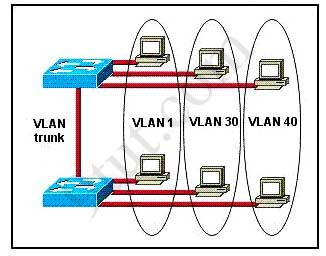
A. one
B. two
C. three
D. four
E. five
F. six
Answer: C
Question 4:
Which type of attack is characterized by a flood of packets that are requesting a TCP connection to a server?
A. denial of service
B. brute force
C. reconnaissance
D. Trojan horse
Answer: A
Question 5:
Refer to the exhibit.
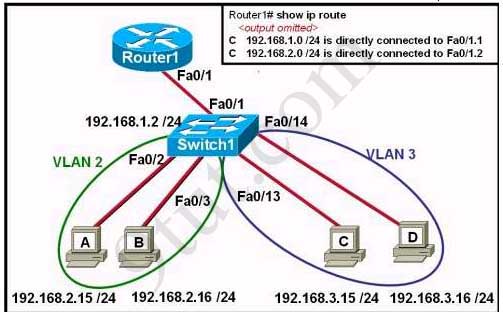
The network administrator has created a new VLAN on Switch1 and added host C and host D. The administrator has properly configured switch interfaces FastEthernet0/13 through FastEthernet0/24 to be members of the new VLAN. However, after the network administrator completed the configuration, host A could communicate with host B, but host A could not communicate with host C or host D. Which commands are required to resolve this problem?
A. Router(config)# interface fastethernet 0/1.3
Router(config-if)# encapsulation dot1q 3
Router(config-if)# ip address 192.168.3.1 255.255.255.0
B. Router(config)# router rip
Router(config-router)# network 192.168.1.0
Router(config-router)# network 192.168.2.0
Router(config-router)# network 192.168.3.0
C. Switch1# vlan database
Switch1(vlan)# vtp v2-mode
Switch1(vlan)# vtp domain cisco
Switch1(vlan)# vtp server
D. Switch1(config)# interface fastethernet 0/1
Switch1(config-if)# switchport mode trunk
Switch1(config-if)# switchport trunk encapsulation isl
Answer: A
Explanation:
Communication between host A and host B on the same VLAN does not need a router but communication between host A and host C (or host D) need a layer 3 device, in this case Router1, which is called a “router on a stick”. From the output of Router1, we notice that there is not any route to the new network 192.168.3.0/24 which host C and host D belong to. Therefore, we need to configure a subinterface for this network.
Question 6:
Refer to the exhibit. What is the most efficient summarization that R1 can use to advertise its networks to R2?
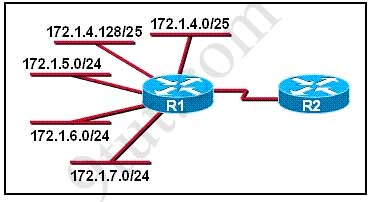
A. 172.1.0.0/22
B. 172.1.0.0/21
C. 172.1.4.0/22
D. 172.1.4.0/24
172.1.5.0/24
172.1.6.0/24
172.1.7.0/24
E. 172.1.4.0/25
172.1.4.128/25
172.1.5.0/24
172.1.6.0/24
172.1.7.0/24
Answer: C
Explanation:
Network 172.1.4.0/25 and network 172.1.4.128/25 can be grouped to a single network 172.1.4.0/24
Network 172.1.4.0/24 + Network 172.1.5.0/24 + Network 172.1.6.0/24 + Network 172.1.7.0/24 can be grouped to a single network 172.1.4.0/22 because we have all 4 subnetworks so we can move left 2 bits (22=4)
Question 7:
Which spread spectrum technology does the 802.11b standard define for operation?
A. IR
B. DSSS
C. FHSS
D. DSSS and FHSS
E. IR, FHSS, and DSSS
Answer: B
Question 8:
A network interface port has collision detection and carrier sensing enabled on a shared twisted pair network. From this statement, what is known about the network interface port?
A. This is a 10 Mb/s switch port.
B. This is a 100 Mb/s switch port.
C. This is an Ethernet port operating at half duplex.
D. This is an Ethernet port operating at full duplex.
E. This is a port on a network interface card in a PC.
Answer: C
Explanation:
Modern Ethernet networks built with switches and full-duplex connections no longer utilize CSMA/CD. CSMA/CD is only used in obsolete shared media Ethernet (which uses repeater or hub).
Question 9:
Refer to the topology and router configuration shown in the graphic. A host on the LAN is accessing an FTP server across the Internet. Which of the following addresses could appear as a source address for the packets forwarded by the router to the destination server?
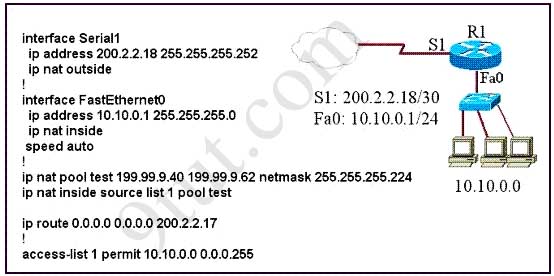
A. 10.10.0.1
B. 10.10.0.2
C. 199.99.9.33
D. 199.99.9.57
E. 200.2.2.17
F. 200.2.2.18
Answer: D
Question 10:
Which routing protocol by default uses bandwidth and delay as metrics?
A. RIP
B. BGP
C. OSPF
D. EIGRP
Answer: D
Question 11:
Refer to the exhibit. The networks connected to router R2 have been summarized as a 192.168.176.0/21 route and sent to R1. Which two packet destination addresses will R1 forward to R2? (Choose two)
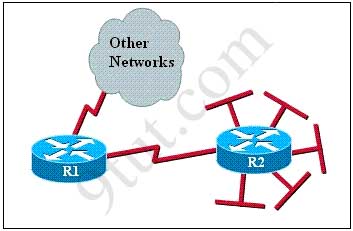
A. 192.168.194.160
B. 192.168.183.41
C. 192.168.159.2
D. 192.168.183.255
E. 192.168.179.4
F. 192.168.184.45
Answer: B E
Explanation:
From the subnet mask of /21, we can specify the network address and broadcast address of this subnetwork:
Increment: 8 of the third octet(/21 = 255.255.248.0 or 1111 1111.1111 1111. 1111 1000.0000 0000)
Network address: 192.168.176.0
Broadcast address: 192.168.183.255 (183 = 176 + 8 – 1)
Therefore all the destination addresses in this range will be forwarded to R2 -> B and E lie in this range and their packages will be forwarded to R2. Please notice that D is an incorrect answer because it is a broadcast address and R1 will drop its packages.
Question 12:
Refer to the exhibit. Which switch provides the spanning-tree designated port role for the network segment that services the printers?
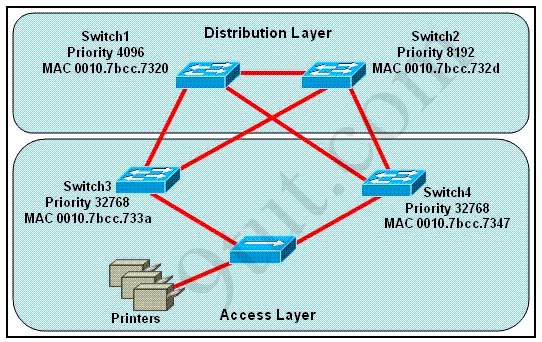
A. Switch1
B. Switch2
C. Switch3
D. Switch4
Answer: C



Reasoning like Berry:
Q12–
3a in decimal = 58
47 in decimal = 71
the correct answer is switch 3.
which network protocol does DNS use?
tcp or udp
in testinside take only udp why? please answer me
can u explan the que,, 6 & 11 plz
@Berry
Please, for the love of all that’s holy. Before you take your exam, learn to do calculations in hexadecimal format.
0x3a = 58 in decimal
0×47 = 71…
Not 47 ffs! You’re saying that you convert the first number from hexadecimal to decimal but you leave the second number as it is!
That means you don’t even know that MAC addresses are compiled by hexadecimal numbers ONLY!
I really wish some 9tut moderator would eventually delete all these INCORRECT and idiotic answers…
@rasha
DNS uses TCP _AND_ UDP. It needs TCP for the DNS zone transfers between the DNS servers and UDP for the communication between server and client.
So Testinside had the wrong answer on that one.
can anyone explain the the commands used in the ans of qns 5? thanks
q9: isn’t it suppose to be answer “F”? as the ip 200.2.2.18 is the ip of the serial interface s1 as showen iin the graphic?
Adil,according to 9tut explanations,the best answer for your question is a) and d)
Thanks,
THEOPHILE
On question 9, couldnt the answer be C (C. 199.99.9.33)? Why not? Why not D.
@Cisco
look at the nat pool configuration on the router
it starts at ip address 199.99.9.40 and ends at 199.99.9.62 so 199.99.9.33 is outside the nat pool. hence answer D
@Kayden
since host A caanot communicate with host C and D and the sh ip route output on the router dow not list 192.168.3.0 network it means that there is no configuration of a sub-interface on the router interface that will act as the gateway for the 192.168.3.0 network.
Your comment is awaiting moderation.
Hello…!9tut,
The network administrator is asked to configure 113 point-to-point links. Which IP addressing scheme best defines the address range and subnet mask that meet the requirement and waste the fewest subnet and host addresses?
A. 10.10.0.0/18 subnetted with mask 255.255.255.252
B. 10.10.0.0/25 subnetted with mask 255.255.255.252
C. 10.10.0.0/24 subnetted with mask 255.255.255.252
D. 10.10.0.0/23 subnetted with mask 255.255.255.252
E. 10.10.0.0/16 subnetted with mask 255.255.255.252
Answer: D
My ans. is B (10.10.0.0/25 subnetted with mask 255.255.255.252)
Can you clear me? pl…
Ok so at the sixth question if there was (172.1.4.0/21) instead of (172.1.4.0/22) would it be a correct answer if so i understood.
Hi, Appreciate if someone could send me the latest dumps at treepanel.ken@hotmail.com , i plan to take the exams at the end of sep.
Thanks.
@Swati: If you will use 10.10.0.0/25 = 10.10.0.0 255.255.255.128
128/4 = 32 subnets but you need to configure 113 p2p links. So you have to use at least 10.10.0.0/23
i.e. 10.10.0.0 255.255.254.0 = 512 ip
512/4 = 128 subnets for p2p links.
@Osman: No.
/21 = 2^3 = 8
It will be acceptable only for:
172.16.0.0
172.16.8.0
172.16.16.0 etc
So if you will use summarization address 172.16.0.0/21 for subnets
172.1.4.0/25
172.1.4.128/25
172.1.5.0/24
172.1.6.0/24
172.1.7.0/24
it will be bad solution because in this case you include extra subnets.
@Dims… why 128/4=32 subnets ?
@dims
nice logic sir
@jcd
you use 4 IPs for each point-to-point subnetwork, correct? (it’s the subnetwork on which there are only 2 devices, has a subnet mask of /30)
that’s why he said 512/4 = 128
explain the answer for question 8 pls
@atot
A network interface port has collision detection…
collision detection is enabled on ports that do not operate in full duplex mode (more than 2 devices share the same line).
…and carrier sensing enabled on a shared twisted pair network. From this statement, what is known about the network interface port?
A. This is a 10 Mb/s switch port.
could be, but unsure
B. This is a 100 Mb/s switch port.
could be, but unsure
C. This is an Ethernet port operating at half duplex.
true. the only thing we can be sure of
D. This is an Ethernet port operating at full duplex.
false
E. This is a port on a network interface card in a PC.
could be, but unsure
I found most of these questions using Cert Magic, but I was wondering were I could get a better Test Engine? Does anyone know who has the most up to date and accurate test Engine? Kendhe1@hotmail.com
Isn’t Q12 not more complicated than that, since there are a number of loops on the topology???
hi 9tut ?
Can you help me in this question ?
Which command reveals the last method used to powercycle the router ?
sh reload
sh boot
sh running-config
sh version.
Answer is Sh version in one the dumps . Can you tell me exact answer ?
@xallax:::
Q1….Why the carrier sensing is used i mean for what purpose???
Q2….Which type of attack is characterized by a flood of packets that are requesting a TCP connection to a server?
A. denial of service
B. brute force
C. reconnaissance
D. Trojan horse
Answer: A
he ot
can any one tell why these other option for??What they do
@cisco craze
Q1 – carrier sensing is used by network devices that share the same network segment to figure out when the network medium is not in use by another device. this is required when using hubs, the connection is set to half-duplex.
Q2:
“A denial-of-service attack (DoS attack) or distributed denial-of-service attack (DDoS attack) is an attempt to make a computer resource unavailable to its intended users.”
http://en.wikipedia.org/wiki/Denial-of-service_attack
thank you for asking, have a nice day
You will have to grasp the art and technology of site visitors for your website. Is the website online without site visitors is like having an ice cream save in the desert, located one hundred km from the nearest highway. It has the best ice cream on this planet, but if somebody enters your store, you’ll be defeated.
hello people i enter exam but dont pass have 800 coz i dont focus on sim lab and i didnt know its take time
wanna ask 9tut and friends here i will enter exam again after 7 days the labs its will be changed or not plz answer me and help
hi can any body answer sm please ?
@sm @abed
only “show version” is correct out of those 4 options given by sm.
Which three statements accurately describe layer 2 Ethernet switches?(choose three)
A. Microsegmentation decreases the number of collisions on the network.
B. if a switch receives a frame for an unkown destination,it uses ARP to resolve the address.
C. Spanning Tree Protocol allows switches to automatically share vlan information.
D. In a properly functioning network with redundant switched paths,each swiched aegment will contain one
root bridge with all its ports in the forwarding state.All other switches in that broadcast domain will have
only one root port.
E. Establishing vlans increases the number of broadcast domains.
F. Switches that are configured with vlans make forwarding decisions based on both layer 2 and layer 3
address information.
Answer: ADF – according to “ask”
Answer: ADE – according to “pass4sure”
can any body help me with this question ?
and what is the meaning of microsegmentation ? :|
@abed
micro = small
segmentation = break something into smaller parts
microsegmentation is the process of splitting one collision domain into as many as possible by using switches (and routers for inter-vlan connectivity).
now… your options were…
A. Microsegmentation decreases the number of collisions on the network.
true. you will try to have only 1 device connected to a switch port.
B. if a switch receives a frame for an unknown destination, it uses ARP to resolve the address.
false. the switch will forward that frame out all ports (except the port on which the frame arrived)
C. Spanning Tree Protocol allows switches to automatically share vlan information.
false. that’s what VTP does.
D. In a properly functioning network with redundant switched paths,each switched segment will contain one root bridge with all its ports in the forwarding state.All other switches in that broadcast domain will have only one root port.
true. there’s one big daddy that will distribute the frames
E. Establishing vlans increases the number of broadcast domains.
true. VLANs are… virtual LANs. every single LAN is a broadcast domain
F. Switches that are configured with vlans make forwarding decisions based on both layer 2 and layer 3 address information.
this is only true for L3 switches. we should assume that the word “switch” refers to “L2 switch” unless otherwise specified. false.
hi all can someone give me the correct answer for this question
in the communication betwen 2 host over the point to point Wan wich protocol or technology :
*IP
*T1
*PPP
*IEEE802.3
plz and thanks
@jawad
answer is IP
http://www.9tut.net/icnd2/miscellaneous-questions
Thank you so much Xallax
Can someone please explain question 12: For some reason, I am having some problems quickly telling which mac address is smaller. I know that the smaller mac will be selected but I need a way to tell quickly in the exam? Anyone?
@jasper
read MAC from left to right
compare each hex bit this:
0-9 – normal comparison
A-F – these are 10, 11, 12, 13, 14, 15.
if you have only arabic numerals then just compare them, easy
if you have to compare an arabic numeral (lets say… 7) with a higher hex value notated by a letter (let’s say… C), then the arabic numeral is smaller (7 < C, keep in mind that C is A, B, C… 10, 11, 12. 7 < 12)
hope this is helpful
Thank you sir, so as long as I compare left to right, I should be fine. Makes sense :)
Hi Friends!! Can someone send me the latest dump? I am writing CCNA exam in the first week of January 2012. I would be really thankful to you.
tashah08@gmail.com
I will appreciate if someone please send the last dump…. i will do this exam in january 2012…. thanks
r_cordob@hotmail.com
Hi forum users !
Hi 9tut… Hi Guys! Can you please help me… I will take exam this Feb. Please send me latest dump so that I will have an idea for the exam.. rico.blake@ymail.com
Thanks Guys!
According to the routing table, where will the router send a packet destined for 10.1.5.65?
Network
@9tut:- @Xallax
According to the routing table, where will the router send a packet destined for 10.1.5.65?
Network interface Next-Hop
10.1.5.0/24 e0 10.1.1.2
10.1.5.64/28 e1 10.1.2.2
10.1.5.64/29 s0 10.1.3.3
10.1.5.64/27 s1 10.1.4.4
at which interface router will send the packet???
@arpit
it will be sent to 10.1.3.3
why? “10.1.5.64/29″ is the most specific entry (has the biggest subnet mask)
@xallax: Can u please elaborate??
router sholud take in to account the cost eo and e1 has heigest cost…
@arpit
the router will pick the route towards the best entry in the routing table
10.1.5.0/24 is 10.1.5.0 ~ 10.1.5.255
10.1.5.64/27 is .64 ~ .95
10.1.5.64/28 is .64 ~ .79
10.1.5.64/29 is .64 ~ .71
it’s obvious that 10.1.5.65 could be a part of all 4 networks, but it will most likely be a part of the entry that represents the smallest subnetwork
which one represents a smaller subnetwork? the one with the /29
Hello Friends, My name is – Theodota . Just saying -rngo to the movies not offer ! I am a normal and decent girl. :) ! Saytik Cool , I hope there will be something to talk about !
Q6 was there in today’s exam.
помогает ли диета при похудении?